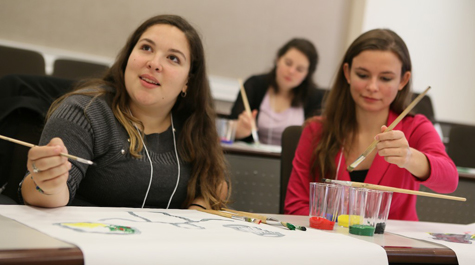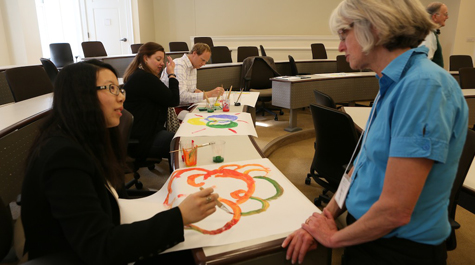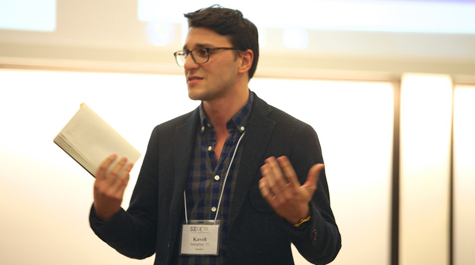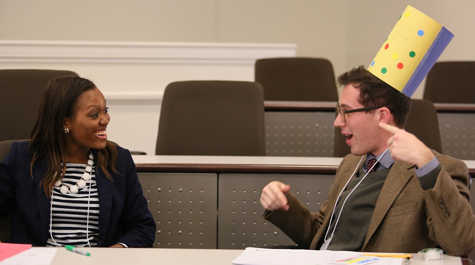The past teaches the future to lead at SECon 2014
In one room, the projector displayed an image of the human brain highlighting empathy nerve centers. In another, a presenter led a diagramming exercise to help participants determine their most marketable career skills. Further down the hall, people expressed their goals by painting.
No, these scenes weren’t from William & Mary’s multifarious course offerings. Instead, they were part of a singular purpose: to provide budding leaders the tools and inspiration needed to engage with the world’s most pressing social concerns.
Over 200 attendees gathered for William & Mary’s fourth annual Social Entrepreneurship Conference (SECon) Nov. 14 held at Miller Hall where an illustrious crowd of alumni returned to share their experiences with students eager to unite business principles and a spirit of community engagement to change the world.
But what exactly is a social entrepreneur?
“A relatively new idea, social entrepreneurs should work with and in communities to apply innovative strategies to work to solve pressing social concerns,” said Drew Stelljes, SECon organizer and assistant vice president for student engagement and leadership. “Social entrepreneurs are persistent, creative, thoughtful, determined visionaries, and there seems no better place than William & Mary to discuss with our students how to launch careers in social entrepreneurship.”
SECon is an event unique to William & Mary and fits the College’s commitment to community service.
“The conference is designed to have William & Mary alumni provide content, practical experience, mentorship and inspiration to William & Mary students,” Stelljes said. “This is a conference exclusively for William & Mary students. It is a testament of our commitment to educating active, engaged, thoughtful citizens who graduate with both practical skill set as well as alumni mentors.”
The ‘chief dreamer’
SECon 2014 opened with an address by George Srour ’05, founder and “chief dreamer” of Building Tomorrow, Inc.
Inspired by the need he saw during an aid trip to Uganda as an undergraduate, Srour launched the nonprofit from an unused room in his parents’ house during the months following his graduation. His vision: to provide educational opportunities to Ugandan children by building schools across Uganda. To date, Building Tomorrow has constructed 25 schools and is on track for 60 schools in the next three years.
Putting a vision into practice, however, is hardly a predictable process. To better equip SECon attendees to realize their visions, Srour devoted his talk to dispelling myths about social entrepreneurship.
“Social entrepreneurs cannot change the world—alone,” he told his audience. “Social entrepreneurs ... need a team to pursue their vision and have a social effect.”
Building on the success of William & Mary’s #NoTitleNeeded campaign, which emphasizes that no formal position is needed to be a leader, Srour posited that students who want to make a difference do not need to establish their own organization from scratch.
“Entities do not solve problems; the people behind them do,” Srour said.
Given that his field is called social entrepreneurship, Srour also pointed out that future social entrepreneurs needed a firm grasp on business principles—especially how to market their ideas.
“You have to figure out how to market yourself. There’s a lot of competition in this space,” he said.
Even so, Srour told his audience that there was one key to social entrepreneurship success without which no endeavor will succeed: passion for the cause.
“Knowledge is nothing without passion,” he said.
The business of making a difference
After the opening address, SECon attendees split into a variety of workshop sessions designed to help students foster relationships with alumni mentors and build the business skills needed for success in social entrepreneurship.
These sessions were a primary draw for many of the student attendees.
“I wanted to come to SECon to learn how to integrate business and community service,” said Laini Boyd ’18, a member of AIM 4, a year-long program sponsored by the Office of Community Engagement for incoming freshmen aspiring to active citizenship.
Maddie Hanborg ’18, another member of the 2014 AIM 4 cohort, came to SECon to get the tools she needs to continue her service work long after her time at William & Mary.
“I think it’s a unique opportunity to see how people in the professional and corporate world have continued living lives of community service and how we can do that in our future as well,” she said.
In one of the sessions, “Social Change + You,” Srour set out to help students like Hanborg recognize how their skills and talents can be turned toward a career in social entrepreneurship. Through a series of interactive exercises, he guided the students in identifying their entrepreneurship-related talents and how their personal mission and brand aligns with that of organizations in which they are interested.
Down the hall, another session led by Chris Adkins, Ph.D. ’09, executive director of William & Mary’s undergraduate business program, set out to foster “eyes of empathy” among attendees.
“You build trust with empathy,” Adkins emphasized to his audience, noting that seeing and feeling as another is essential to effective social entrepreneurship.
Throughout the day, attendees and presenters alike interacted, forming lasting connections—one of SECon’s most important purposes.
“Most social entrepreneurs found their inspiration through meeting someone who already was doing something in this area, so I think that all of the presenters welcome this kind of direct interaction with students who are interested in pursuing similar interests,” said Rodney Willette’85, J.D. ’90, vice president of business strategy for Impact Makers, who led a session about a for-profit business model in which all profits are donated to charity.
“I find that every time that I speak to a group of students, particularly a group of William & Mary students, they have incredibly creative ideas to share about a venture that may be able to address a particular social or environmental problem that we are facing. And I have seen some of those William & Mary students turn those concepts into actual social enterprises that they are leading today,” he added.
SECon 2014 helped provide its attendees with the tools and connections they need to realize their visions—something the conference’s organizers and speakers have no doubts will happen.
“The moral of the story is that you never really know where you are going to end up. But it is the passion, it is the commitment that continues to drive you forward,” Srour told the gathered attendees.
“The world needs you,” he said.


















